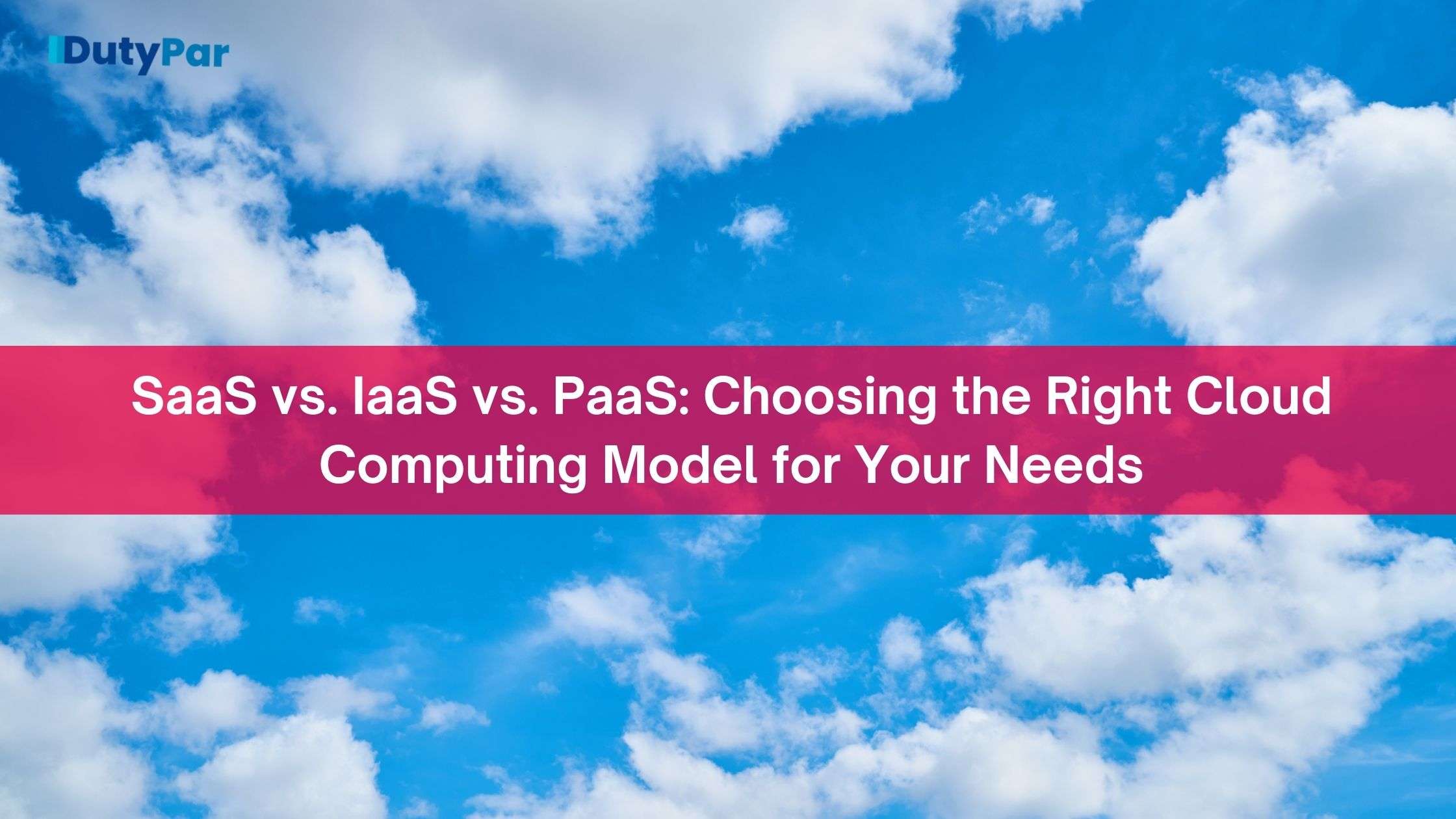This blog explores the key differences between SaaS, IaaS, and PaaS cloud computing models, offering guidance on selecting the right model based on your business goals, budget, technical expertise, and security needs. It emphasizes the importance of understanding each model’s benefits and how they align with your specific requirements.

Table of Contents
Introduction
Cloud computing has revolutionized the way businesses operate over the internet. Instead of investing in expensive hardware and software, businesses can use cloud computing services to rent computing resources as needed. Cloud computing has become increasingly popular over the years, with businesses of all sizes adopting this technology. However, with so many different types of cloud computing services available, it can be difficult to choose the right one for your needs. In this article, we will explore the three main types of cloud computing services—SaaS, IaaS, and PaaS—and help you determine which one is right for your business.
What is cloud computing?
Cloud computing is a type of computing that allows users to access computing resources, such as servers, storage, and databases, over the internet.
Instead of owning and maintaining their own hardware and software, businesses can use cloud computing services to rent these resources as needed.
This allows businesses to scale up or down their computing resources as needed without having to make large upfront investments in hardware and software.
Types of cloud computing
There are three main types of cloud computing services: SaaS, IaaS, and PaaS. Each of these services provides different levels of control and flexibility, depending on the needs of the business.
Software as a Service (SaaS)
• Software as a Service (SaaS) is a cloud computing service that provides access to software applications over the internet.
• With SaaS, businesses can use software applications without having to install, maintain, or upgrade them.
• SaaS applications are typically accessed through a web browser and are hosted and managed by the cloud provider.
• SaaS is a popular choice for businesses that need access to software applications but don’t want to invest in the infrastructure needed to run them.
• SaaS applications are also typically priced on a subscription basis, which can be more cost-effective than purchasing and maintaining software licenses.
Infrastructure as a Service (IaaS)
• Infrastructure as a Service (IaaS) is a cloud computing service that provides over the internet.
• With IaaS, businesses can rent virtual machines, storage, and other computing resources from a cloud provider.
• IaaS allows businesses to have complete control over their computing environment, including the operating system, middleware, and applications.
• IaaS is a popular choice for businesses that need complete control over their computing environment and have the expertise to manage it.
• IaaS is also a good choice for businesses that need to scale up or down their computing resources quickly, as resources can be added or removed on demand.
Platform as a Service (PaaS)
• Platform as a Service (PaaS) is a cloud computing service that provides access to a computing platform over the internet.
• With PaaS, businesses can develop, test, and deploy applications without having to manage the underlying infrastructure.
• PaaS provides a complete environment for developing and deploying applications, including the operating system, middleware, and runtime environment.
• PaaS is a popular choice for businesses that need to develop and deploy applications quickly without having to worry about the underlying infrastructure.
• PaaS also provides a high level of scalability and flexibility, as resources can be added or removed on demand.
Cloud Deployment Models
In addition to the different types of cloud computing services, there are also different cloud deployment models: public cloud, private cloud, and hybrid cloud.
Public Cloud
• Public cloud refers to cloud computing services that are available to the general public over the internet.
• Public cloud services are typically provided by large cloud providers such as Amazon Web Services (AWS), Microsoft Azure, and Google Cloud Platform Public cloud services are popular because they are easy to access and can be quickly scaled up or down to meet changing business needs.
• Public cloud services are typically priced on a pay-as-you-go basis, which can be more cost-effective for businesses that have fluctuating computing needs.
Private Cloud
• Private cloud refers to cloud computing services that are used exclusively by a single organization.
• Private cloud services can be hosted on-premises or by a third-party cloud provider.
Private cloud services provide more control and customization options than public cloud services, but are typically more expensive to set up and maintain.
• Private cloud services are popular with large organizations that need to comply with strict security and compliance regulations and require a high level of control over their computing environment.
Hybrid Cloud
• Hybrid cloud refers to a cloud computing environment that combines both public and private cloud services.
• Hybrid cloud environments allow businesses to take advantage of the scalability and cost-effectiveness of public cloud services while also maintaining control over their sensitive data and applications in a private cloud environment.
• Hybrid cloud environments can be complex to set up and manage, but they provide businesses with the flexibility to balance their computing needs between public and private cloud services.
Choosing the Right Cloud Computing Model for Your Needs
Choosing the right cloud computing model for your needs depends on a variety of factors, including your business goals, budget, and technical expertise.
Here are some key considerations to keep in mind when choosing a cloud computing model:
Business Goals: Consider your business goals and what you hope to achieve with cloud computing. Are you looking to improve collaboration among your employees? Do you need to scale up your computing resources quickly to meet seasonal demand? Understanding your business goals can help you choose a cloud computing model that aligns with your needs.
Budget: Cloud computing services can be more cost-effective than investing in your own hardware and software, but costs can add up quickly if you don’t choose the right model for your needs. Consider your budget and how much you are willing to spend on cloud computing services.
Technical Expertise: Different cloud computing models require different levels of technical expertise. If you have a dedicated IT team with expertise in managing infrastructure, IaaS may be a good choice for your business. If you are looking for a more turnkey solution, SaaS may be a better fit.
Scalability: Consider how quickly you need to scale up or down your computing resources. If you need to quickly add or remove resources, IaaS or PaaS may be a better fit than SaaS.
Security: Consider the security and compliance requirements of your business. If you need to comply with strict security regulations, a private cloud or hybrid cloud environment may be a better fit than a public cloud environment.
Conclusion
Cloud computing has revolutionized the way businesses operate, providing access to computing resources over the internet without having to invest in expensive hardware and software.
When choosing a cloud computing model, it’s important to consider your business goals, budget, technical expertise, scalability needs, and security requirements. By understanding the different types of cloud computing services and deployment models available, you can choose the right cloud computing model for your business and take advantage of the scalability, flexibility, and cost-effectiveness of cloud computing.





